Key Insights
| A report by Numbeo’s Crime in Halifax Index found that the city’s crime level is moderate at 40.89. The same study found that nighttime safety attitudes in Halifax drop when compared to morning attitudes, as only 46.91% of people surveyed say they would feel safe walking alone during the night. Data from Statistics Canada shows that in 2023, the national Crime Severity Index was 80.5, up 2% from 2022 and 17% from a decade ago. A study by AreaVibes reveals that Moser River is the most dangerous neighborhood in Halifax, with 76.5% more violent crimes than the citywide average. Research by the Government of Nova Scotia found that Halifax youth crime has noted a staggering increase in 2023, posting a crime rate of 2,680.7 offenses for every 100,000 persons aged 12 to 17 years. |
Halifax, the capital of Nova Scotia, has seen fluctuations in crime trends over recent years. While it’s not among Canada’s most dangerous cities, perceptions of crime in the city do reveal some concerning trends.
According to Numbeo’s Crime in Halifax Index, Halifax has a moderate crime level (40.89). However, there are still concerns about crime in Halifax, particularly property crimes and drug-related offenses.
In 2025, 68.45% of residents believe crime has increased over the past five years, reflecting a shift in public perception.
However, some types of crime are quite low in terms of perceived fear. Fear of being physically attacked, for instance, is 33.43%, while fear of bias-motivated attack is even lower at 20.80%.
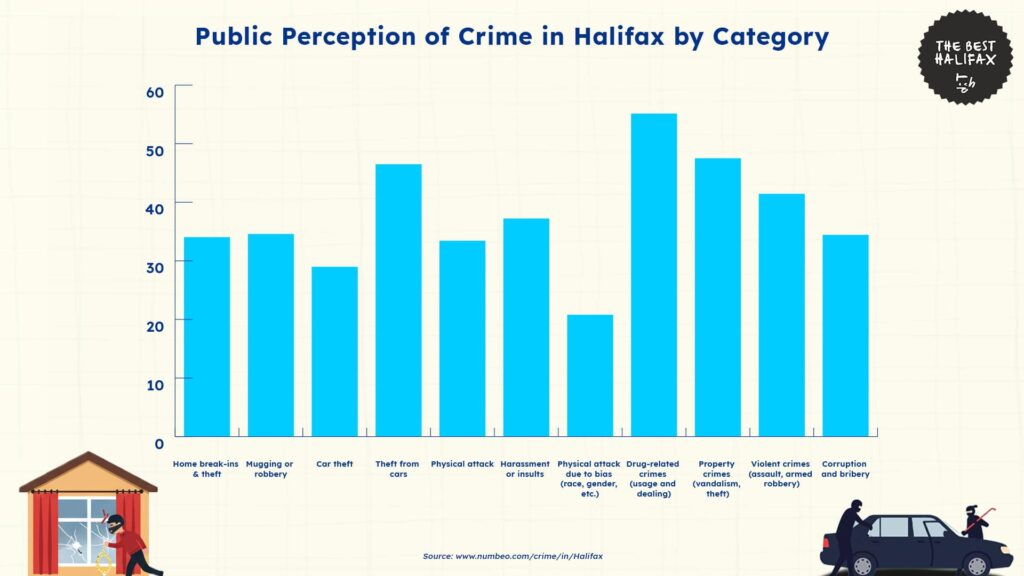
Despite crime fears, safety during the day is high in Halifax, with 81.85% of Halifax citizens reporting feeling safe walking alone during the day.
This would suggest that most public spaces, workplaces, and neighborhoods have a safe environment in which to conduct daily routines.
However, nighttime safety attitudes are significantly lower, with only 46.91% of residents reporting they would feel safe walking alone at night.
This reflects common concerns in urban areas where reduced visibility, fewer pedestrians, and potential criminal activity contribute to heightened caution.
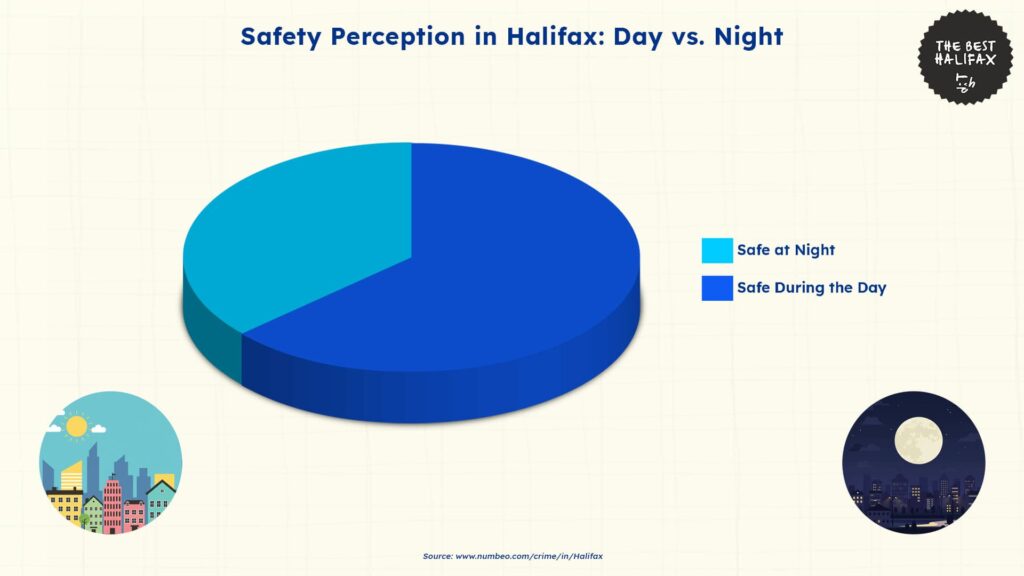
Crime Severity Across Regions in Canada
Data from Statistics Canada shows that crime severity in Canada is widely differentiated provincially and territorially, with some areas having higher crime severity than others.
For 2023, the national Crime Severity Index was 80.5, up 2% from 2022 and 17% from a decade ago.
The overall reported crime nationally was 2,342,932 incidents, with the national crime rate at 5,843 per 100,000 population – a 3% increase over the last year.
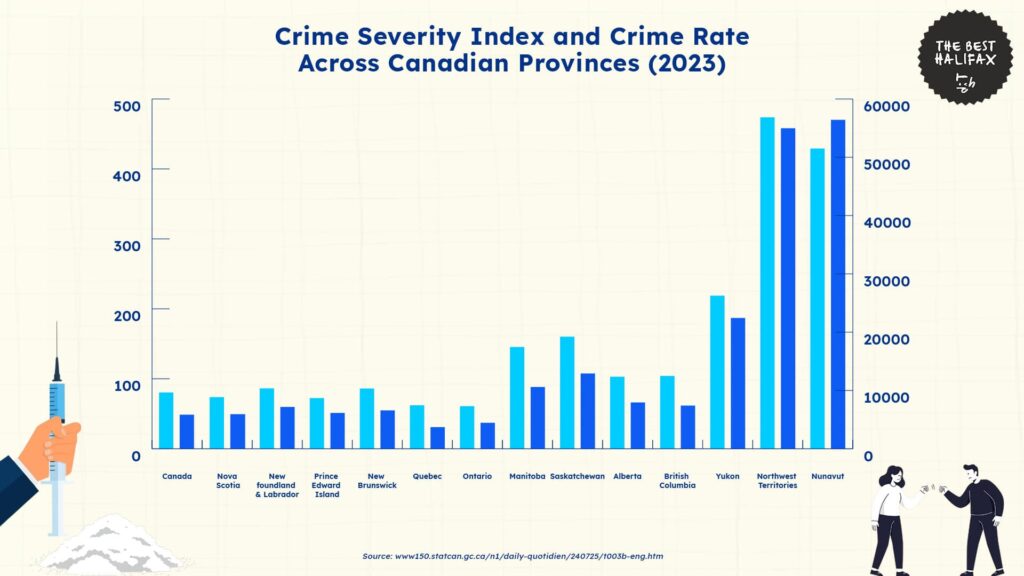
Halifax, being a part of Nova Scotia, had a Crime Severity Index (CSI) of 73.8 in 2023, which is 1% lower than the previous year.
It is just below the national CSI of 80.5, meaning that the crime rate in Halifax and surrounding areas is slightly lower than the Canadian average.
Nova Scotia’s crime rate was 5,933 per 100,000 citizens, which is higher than the national rate of 5,843 per 100,000.
Meanwhile, Newfoundland & Labrador recorded a CSI of 86.3, 17% higher than Nova Scotia, and a crime rate of 7,175 per 100,000 population, 21% higher than Nova Scotia.
Prince Edward Island also scored lower on the CSI (72.4) but higher in crime rate (6,147 per 100,000) and indicates more but less serious crimes.
New Brunswick, with a CSI of 86.1, shared the same crime rate (6,587 per 100,000), but with an increase of 1% from the previous year, compared to Nova Scotia’s decline.
Although Halifax has a relatively low crime severity index, it is much safer than western provinces like Manitoba (CSI: 145.5, crime rate: 10,599 per 100,000) and Saskatchewan (CSI: 160.2, crime rate: 12,909 per 100,000).
10 Most Dangerous Neighborhoods in Halifax
AreaVibes highlights the neighborhoods in Halifax with the highest rates of violent crimes per 100,000 residents.
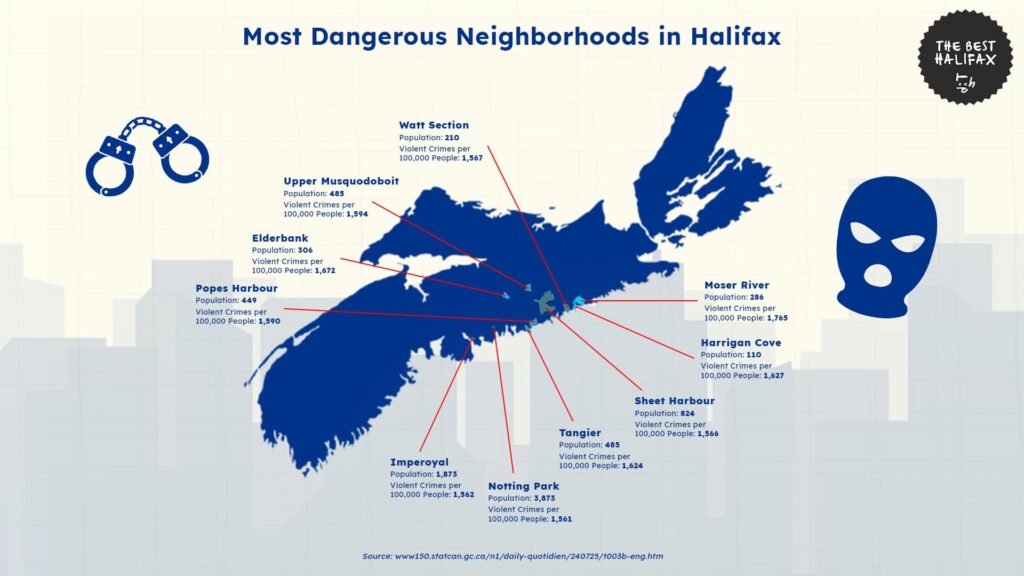
Moser River, which is the most dangerous neighborhood, has 1,765 violent crimes per 100,000 inhabitants. This is 76.5% above the city average of approximately 1,103 incidents per 100,000 people.
This implies that the people living in this neighborhood are almost twice as likely to be subjected to violent crime as those in other neighborhoods in Halifax.
The crime rate in Moser River can be attributed to a lack of economic opportunities, fewer police patrols, or increased cases of social issues like drug addiction and poverty.
Likewise, violent crime stands at 1,672 in Elderbank and 1,627 in Harrigan Cove per 100,000. These numbers are 67.2% and 62.7% higher than in Halifax, respectively.
Demographic Breakdown of Crime Statistics in Halifax
Youth Crime in Halifax
A report by the Government of Nova Scotia reveals that youth crime remains a significant concern in Halifax, as well as across Nova Scotia.
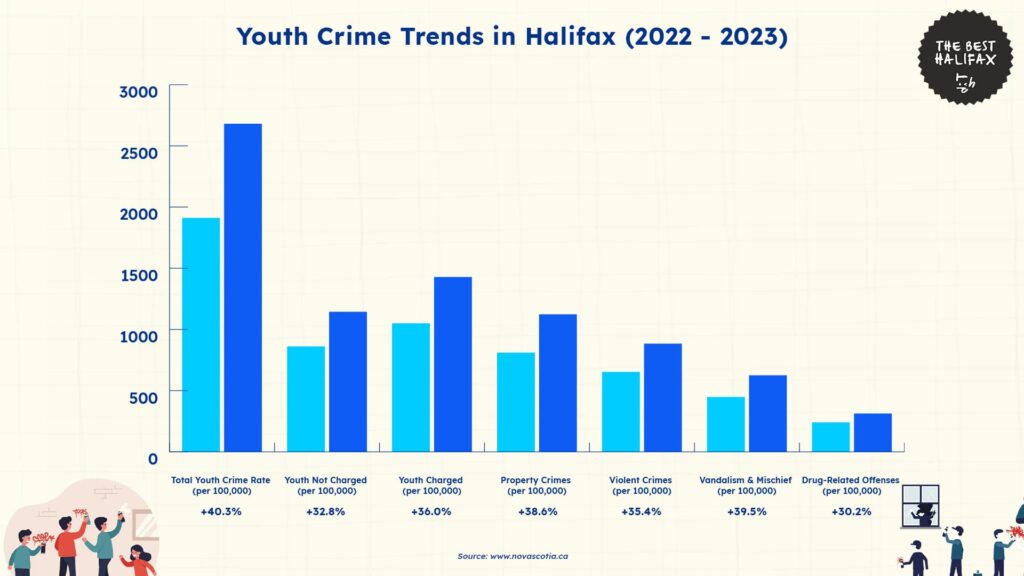
Halifax youth crime has recorded a dramatic rise in 2023, with a crime rate of 2,680.7 offenses per 100,000 people aged 12 to 17 years. The most concerning trend is the enormous 40.3% spike from 2022.
Moreover, 1,144.3 per 100,000 youth have been involved in reported offenses but not charged, and 1,428.5 per 100,000 have been charged.
The large percentage of youth charged over being diverted from the criminal justice system suggests that the majority of cases are serious crimes and must be processed legally.
Meanwhile, the 40.3% increase in juvenile crime reflects an increasing trend of property crime, assault, vandalism, and perhaps gang activity.
Several factors may be responsible for this trend, such as economic deprivation, school dropout, absence of community programs, and exposure to high-risk environments.
Gender and Crime in Halifax
Statistics Canada’s Safe Cities Profile Series reveals how crime impacts individuals differently based on gender.
In Halifax, gender-related crime statistics highlight the disproportionate experience of victimization among women, particularly in cases of sexual harassment and assault.
The table below reveals these gender disparities in crime victimization in Halifax.
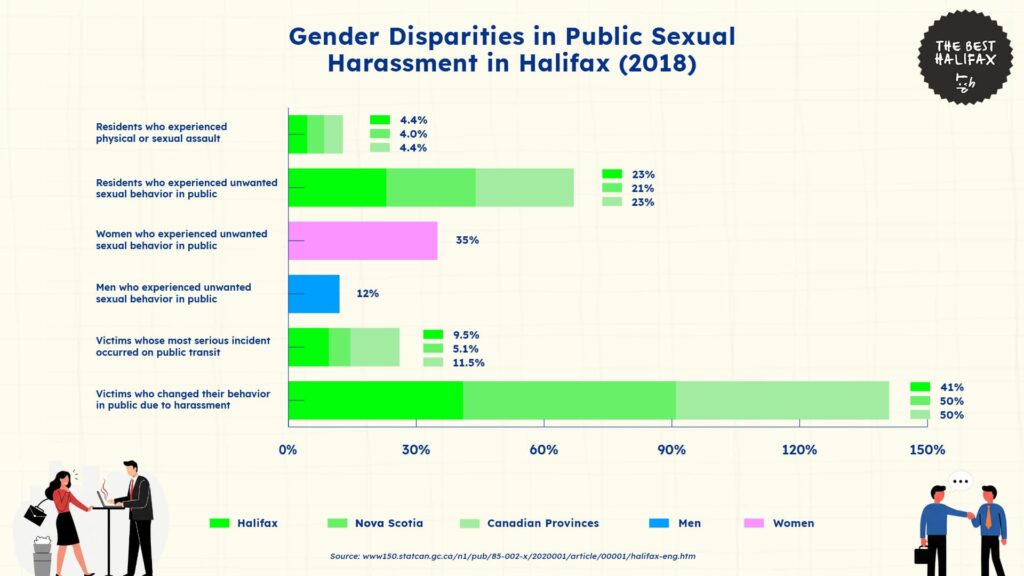
In 2018, 4.4% of Halifax individuals indicated that they were victims of physical or sexual assault, comparable to Nova Scotia (4.0%) and Canada’s provinces as a whole (4.4%).
However, gender inequalities are especially highlighted in instances of unwanted sexual behavior in public, which remains a major concern in Halifax.
Nearly one in four (23%) Halifax residents experienced unwanted sexual behavior in public, which is consistent with provincial (21%) and national (23%) rates.
Women were significantly more likely to experience such behavior, with 35% of women reporting incidents compared to only 12% of men.
This means that women in Halifax are nearly three times more likely to face public sexual harassment than men.
Of those who had reported encountering unwelcome sexual behavior in public spaces, 9.5% indicated that the worst occurrence had taken place on public transit.
This is almost twice as high as the rate in Nova Scotia (5.1%), suggesting that public transportation may be a particular area of concern for safety.
However, Halifax’s rate is closer to the national average (11.5%), indicating that this is a broader issue affecting cities across Canada.
As a response to these experiences, 41% of Halifax residents who were victims of unwanted sexual behavior in public reported that they altered their behavior when in public places to avoid further victimization.
This is below the Nova Scotia figure of 50% and the Canadian provincial average of 50%, but still highlights the significant impact of these incidents on personal freedom and public safety.
Costs and Consequences of Crime in Halifax
Crime places a heavy financial and social cost on Halifax, impacting individuals, communities, and the economy as a whole.
Statistics Canada found that the total tangible social and economic costs of criminal code offenses in Canada were approximately $31.4 billion, which is a per capita cost of $943 annually.
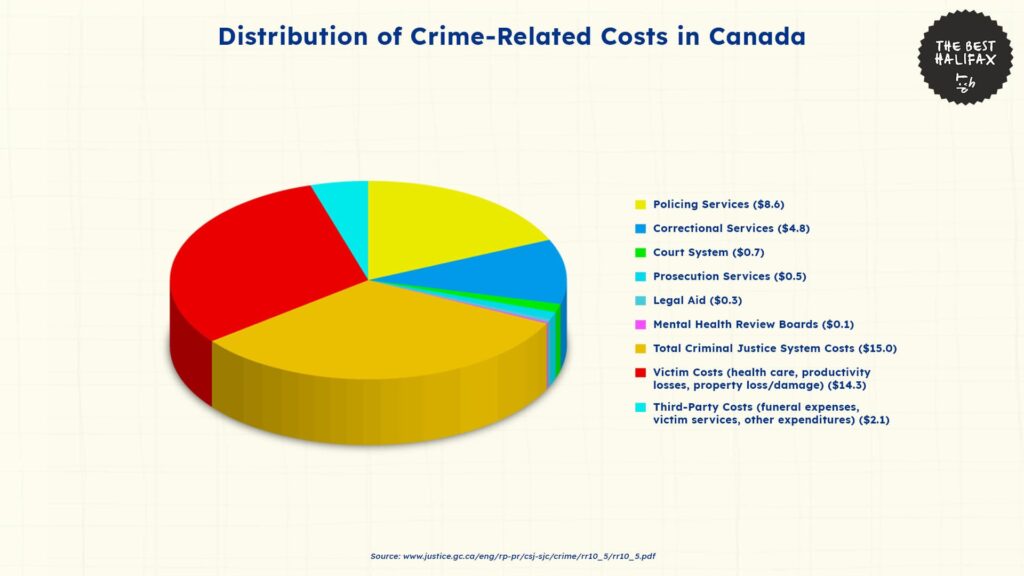
The report found that the estimated annual tangible cost of crime in the city amounts to approximately $351.5 million.
Direct costs that have been factored into this cost include law enforcement, the administration of the courts, corrections, victim assistance, and third-party costs linked with criminality.
Since Halifax is the largest city in Nova Scotia, its contribution to crime-related costs is presumably high relative to other cities within the province.
In addition to direct dollar costs, crime also has great intangible costs, especially emotional suffering, bodily injury, and loss of quality of life by victims and their families.
In 2008, the estimated national cost of pain and suffering caused by crime was $35.8 billion, significantly exceeding the total tangible crime costs of $31.4 billion across Canada.
In addition, victims of violent crime can also suffer long-term mental illness, such as post-traumatic stress disorder (PTSD), anxiety, and depression, which contribute to lost productivity, greater healthcare costs, and decreased well-being overall.
Moreover, high crime rates also lead to a decrease in public confidence, fear of being victimized, and attitudinal shifts, like not going to certain areas, reducing the use of public transport, or spending more on security.
Interventions and Solutions to Crime in Halifax
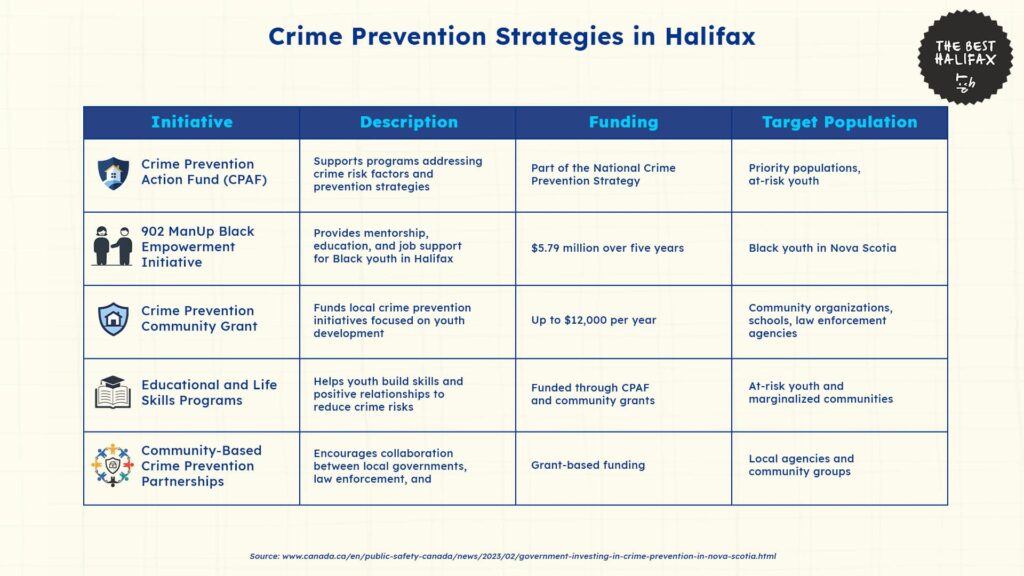
The Government of Nova Scotia has employed various crime prevention strategies focused on young crime, enhanced community outreach, and safer communities.
One of the significant interventions is the Crime Prevention Action Fund (CPAF), which offers targeted funds to address determinants of crime and promote protective measures.
Furthermore, in 2023, the Government of Canada provided $5.79 million in CPAF support to the 902 ManUp Black Empowerment Initiative in Halifax.
The program offers safe spaces, mentorship, and educational resources to assist Black youth in Nova Scotia in overcoming obstacles to education and employment, making them less likely to be involved in criminal activity.
Additionally, the Crime Prevention Community Grant program provides up to $12,000 annually to community organizations focused on youth-directed crime prevention projects.
These grants fund education, social, and life-skills programming to ensure that young people are exposed to positive influences and opportunities that can guide them away from criminal activity.
These initiatives highlight the importance of early intervention, community-driven solutions, and support for at-risk youth as essential strategies for reducing crime in Halifax.
Projections
The future of crime in Halifax will largely depend on the effectiveness of ongoing prevention initiatives, economic conditions, and law enforcement strategies.
While recent investments in youth mentorship, education, and community-driven crime reduction programs aim to lower crime rates, factors such as population growth, economic disparities, and technological advancements in crime will shape future trends.
One of the possible challenges is the growing digitalization of crime, with cybercrime offenses on the rise. Fraud, identity theft, and online exploitation are likely to increase, and law enforcement will need to evolve to meet new threats.
However, with continued government support, data-driven policing, and stronger community engagement, Halifax can be expected to experience declines in violent and property crime in the next decade.
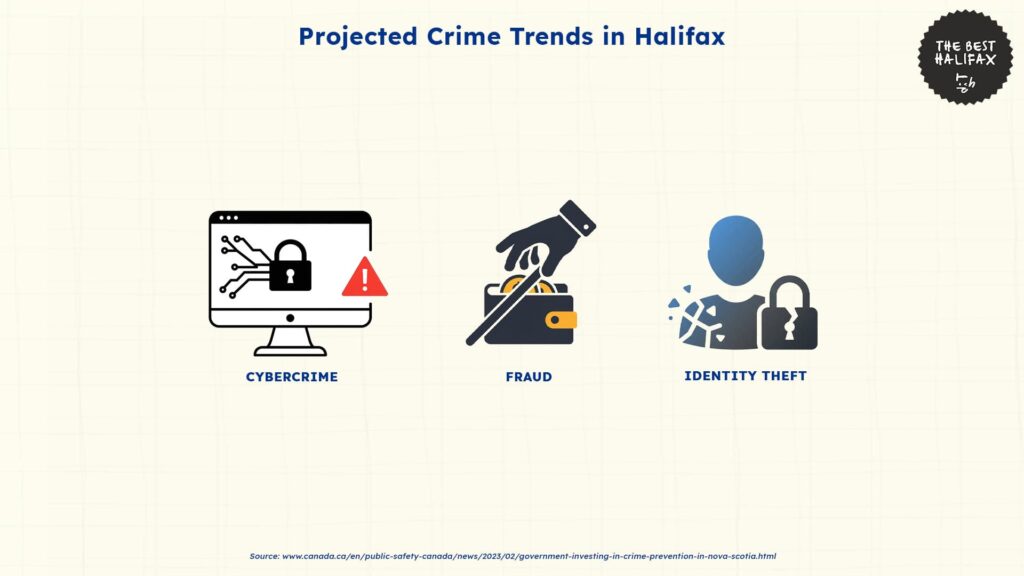
References
- Numbeo. (2024). Crime in Halifax. Retrieved from https://www.numbeo.com/crime/in/Halifax
- Statistics Canada. (2024, July 25). Table 003B: Crime Statistics in Canada. Retrieved from https://www150.statcan.gc.ca/n1/daily-quotidien/240725/t003b-eng.htm
- AreaVibes. (2024). Most dangerous neighborhoods in Halifax. Retrieved from https://www.areavibes.com/halifax-ns/most-dangerous-neighborhoods/
- Statistics Canada. (2020). Halifax crime trends and statistics. Retrieved from https://www150.statcan.gc.ca/n1/pub/85-002-x/2020001/article/00001/halifax-eng.htm
- Department of Justice Canada. (2010). Costs of crime in Canada, 2008. Retrieved from https://www.justice.gc.ca/eng/rp-pr/csj-sjc/crime/rr10_5/rr10_5.pdf
- Public Safety Canada. (2023, February 28). Government investing in crime prevention in Nova Scotia. Retrieved from https://www.canada.ca/en/public-safety-canada/news/2023/02/government-investing-in-crime-prevention-in-nova-scotia.html
- Halifax Regional Police. (2024). Programs and services. Retrieved from https://www.halifax.ca/safety-security/police/programs-services
- Nova Scotia Finance and Treasury Board. (2024). Nova Scotia youth crime rate and statistics. Retrieved from https://novascotia.ca/finance/statistics/archive_news.asp?id=20135&dg=&df=&dto=0&dti=3#:~:text=Nova%20Scotia’s%20youth%20crime%20rate,higher%20in%20Manitoba%20and%20Saskatchewan





